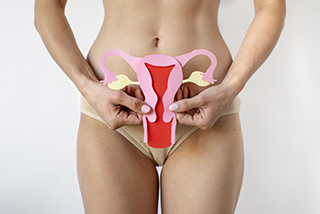Enlargement and loosening of the vagina may develop due to advancing age, multiple number of vaginal births, traumatic vaginal birth, history of giving birth to a large baby (>4000 gr), genetic causes, structural looseness and weight gain or loss. The main factor caused by these conditions is the loss of strength of the vaginal walls and supporting tissues, and tears in the pelvic muscles. Vaginal loosening is considered a precursory sign of future bladder prolapse (cystocele), uterine prolapse or herniation of the anus into the vagina (rectocele). It can also cause decreased sensation in the vagina. Therefore, it may lead to sexual problems for couples.
 The surgery for correcting the sagging of the vaginal walls and tissue damage of the inner lining of the vaginal walls is called ‘Vaginoplasty’. It can be defined as surgical narrowing of the vagina, in a sense, causing vaginal tightening. However, since tissue damage and decrease in connective tissue support can occur in different parts of the vagina, the surgical technique applied varies according to the damaged area. For example, in case of prolapse of the urinary bladder due to damage to the anterior vaginal wall (cystocele), repair is performed on the anterior vaginal wall, while in case of herniation of the last part of the large intestine into the vaginal cavity due to damage to the posterior vaginal wall (rectocele), posterior wall repair is performed. Surgical reconstruction of the perineum (Perineoplasty) is usually performed during vaginoplasty.
The surgery for correcting the sagging of the vaginal walls and tissue damage of the inner lining of the vaginal walls is called ‘Vaginoplasty’. It can be defined as surgical narrowing of the vagina, in a sense, causing vaginal tightening. However, since tissue damage and decrease in connective tissue support can occur in different parts of the vagina, the surgical technique applied varies according to the damaged area. For example, in case of prolapse of the urinary bladder due to damage to the anterior vaginal wall (cystocele), repair is performed on the anterior vaginal wall, while in case of herniation of the last part of the large intestine into the vaginal cavity due to damage to the posterior vaginal wall (rectocele), posterior wall repair is performed. Surgical reconstruction of the perineum (Perineoplasty) is usually performed during vaginoplasty.
Vaginoplasty is an operation that provides much more functional gains in terms of results compared to other genital aesthetic surgeries.
What is vaginal tightening surgery (vaginoplasty)?
Vaginal tightening (Vaginoplasty) is a surgery performed to restore the vagina to its former tightness and narrowness, if it has become enlarged, loose and lost its elasticity. It is an operation performed for both aesthetic and functional purposes. During vaginoplasty, reconstruction of the perineum (perineoplasty)is also performed.
What are the benefits of vaginoplasty?
With vaginal tightening surgery, vaginal wall damage is corrected and reduced vaginal support is restored. Thus, bladder prolapse (cystocele), uterine prolapse or herniation of the last part of the large intestine into the vaginal cavity (rectocele) are treated. In addition, the vagina that becomes loose and loses its elasticity can lead to a decrease in sexual pleasure, loss of sensation and orgasm problems in both men and women. Thus, vaginoplasty can contribute to increased sexual pleasure and have a positive effect on sexual functions.
Am I a suitable candidate for vaginal tightening surgery?
Pregnant women, breastfeeding mothers, those who plan vaginal birth afterwards, those with psychiatric illness and those with genital infections are not eligible for this surgery.
What are the risks of vaginal tightening surgery?
In vaginoplasty, there are risks such as bleeding, infection, oedema, premature opening of the stitches, narrowing the vagina more than necessary. These risks are very rare with proper surgical technique and care, and proper postoperative care.
What should I do before the operation?
Hair removal of the external genital area should be done.
Step by step operation process:
Anaesthesia: General anaesthesia is applied.
Surgical procedure: The patient’s age; menopausal status; sexual activity; presence of any chronic disease, organ prolapse, urinary incontinence, and history of previous operations in this area are taken into consideration and an individually tailored surgical technique is determined for the patient.
What should I expect after vaginal tightening surgery?
After vaginoplasty, pain, swelling, mild bleeding in the form of leakage for a few days and itching in the suture area may be observed. Complaints will decrease over time.
What should I pay attention to after vaginal tightening surgery?
Wound care should be done as recommended by your doctor. The first 3 days should be spent resting at home. The recommended treatment should be followed. Anti-constipation medication should be used for a week. You should pay attention to the cleanliness of the genital area and pay attention to your diet. Also, let us remind you that smoking negatively affects wound healing by impairing oxygenation in tissues. After one week, it is recommended to perform Kegel exercises. These exercises strengthen the pelvic muscles and make the results of the operation more satisfactory.
How long should I rest after vaginal tightening surgery?
Home rest is recommended for 3 days after vaginoplasty.
When can I return to work after vaginal tightening surgery?
You can start working one week after vaginoplasty.
How long is the recovery period after vaginal tightening surgery?
The recovery period after vaginoplasty is approximately 4-6 weeks. You can have intercourse after 8 weeks.
What are the results of vaginal tightening surgery?
Vaginoplasty allows the vagina to regain its former tightness and narrowness. If there is organ prolapse, this condition is corrected. The decrease in sexual pleasure, which can be seen due to the enlargement of the vagina, improves after surgery.


Leave a Reply
You must be logged in to post a comment.